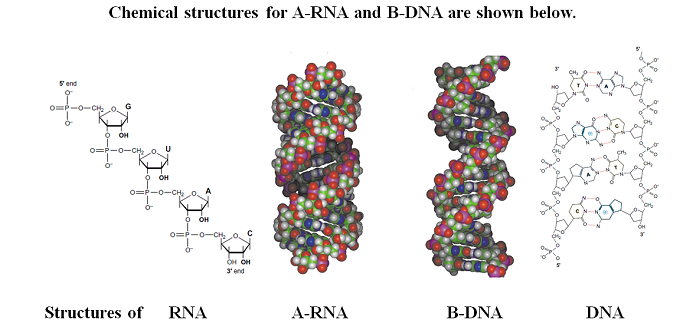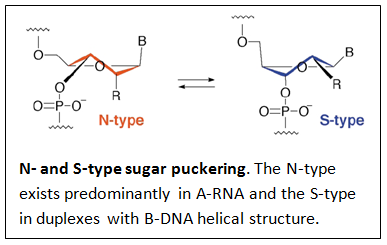Bridged Nucleic Acid on:
[Wikipedia]
[Google]
[Amazon]
A bridged nucleic acid (BNA) is a modified

 An increased conformational inflexibility of the sugar moiety in
An increased conformational inflexibility of the sugar moiety in  BNA
BNA  New BNA analogs introduced by Imanishi's group were designed by taking the length of the bridged
New BNA analogs introduced by Imanishi's group were designed by taking the length of the bridged 
RNA
Ribonucleic acid (RNA) is a polymeric molecule essential in various biological roles in coding, decoding, regulation and expression of genes. RNA and deoxyribonucleic acid ( DNA) are nucleic acids. Along with lipids, proteins, and carbohydra ...
nucleotide. They are sometimes also referred to as constrained or inaccessible RNA molecules
A molecule is a group of two or more atoms held together by attractive forces known as chemical bonds; depending on context, the term may or may not include ions which satisfy this criterion. In quantum physics, organic chemistry, and bioche ...
. BNA monomers
In chemistry, a monomer ( ; ''mono-'', "one" + '' -mer'', "part") is a molecule that can react together with other monomer molecules to form a larger polymer chain or three-dimensional network in a process called polymerization.
Classification
M ...
can contain a five-membered, six-membered or even a seven-membered bridged structure with a "fixed" C3'-endo sugar puckering. The bridge is synthetically incorporated at the 2', 4'-position of the ribose to afford a 2', 4'-BNA monomer. The monomers can be incorporated into oligonucleotide
Oligonucleotides are short DNA or RNA molecules, oligomers, that have a wide range of applications in genetic testing, research, and forensics. Commonly made in the laboratory by solid-phase chemical synthesis, these small bits of nucleic acids c ...
polymeric structures using standard phosphoamidite chemistry. BNAs are structurally rigid oligo-nucleotides with increased binding affinities and stability.
Chemical structures
Chemical structures of BNA monomers containing a bridge at the 2', 4'-position of the ribose to afford a 2', 4'-BNA monomer as synthesized by Takeshi Imanishi's group. The nature of the bridge can vary for different types of monomers. The 3D structures for A-RNA and B-DNA were used as a template for the design of the BNA monomers. The goal for the design was to find derivatives that possess high binding affinities with complementary RNA and/or DNA strands.
 An increased conformational inflexibility of the sugar moiety in
An increased conformational inflexibility of the sugar moiety in nucleosides
Nucleosides are glycosylamines that can be thought of as nucleotides without a phosphate group. A nucleoside consists simply of a nucleobase (also termed a nitrogenous base) and a five-carbon sugar (ribose or 2'-deoxyribose) whereas a nucleotide ...
(oligonucleotides) results in a gain of high binding affinity with complementary single-stranded RNA and/or double-stranded DNA. The first 2',4'-BNA (LNA) monomers were first synthesized by Takeshi Imanishi's group in 1997 followed independently by Jesper Wengel's group in 1998.
 BNA
BNA nucleotides
Nucleotides are organic molecules consisting of a nucleoside and a phosphate. They serve as monomeric units of the nucleic acid polymers – deoxyribonucleic acid (DNA) and ribonucleic acid (RNA), both of which are essential biomolecules w ...
can be incorporated into DNA or RNA oligonucleotides
Oligonucleotides are short DNA or RNA molecules, oligomers, that have a wide range of applications in genetic testing, research, and forensics. Commonly made in the laboratory by solid-phase chemical synthesis, these small bits of nucleic acids ...
at any desired position. Such oligomers are synthesized chemically and are now commercially available. The bridged ribose conformation enhances base stacking and pre-organizes the backbone of the oligonucleotide significantly increasing their hybridization properties.
The incorporation of BNAs into oligonucleotides allows the production of modified synthetic oligonucleotides with
equal or higher binding affinity against a DNA or RNA complement with excellent single-mismatch discriminating power;
better RNA selective binding;
stronger and more sequence selective triplex-forming characters;
pronounced higher nuclease resistance, even higher than Sp-phosphorothioate analogues; and
good aqueous solubility
In chemistry, solubility is the ability of a substance, the solute, to form a solution with another substance, the solvent. Insolubility is the opposite property, the inability of the solute to form such a solution.
The extent of the solubil ...
of the resulting oligonucleotides when compared to regular DNA or RNA oligonucleotides.
 New BNA analogs introduced by Imanishi's group were designed by taking the length of the bridged
New BNA analogs introduced by Imanishi's group were designed by taking the length of the bridged moiety
Moiety may refer to:
Chemistry
* Moiety (chemistry), a part or functional group of a molecule
** Moiety conservation, conservation of a subgroup in a chemical species
Anthropology
* Moiety (kinship), either of two groups into which a society is ...
into account. A six-membered bridged structure with a unique structural feature (N-O bond) in the sugar moiety was designed to have a nitrogen atom. This atom improves the formation of duplexes and triplexes by lowering the repulsion between the negatively charged backbone phosphates. These modifications allow to control the affinity towards complementary strands, regulate resistance against nuclease degradation and the synthesis of functional molecules designed for specific applications in genomics. The properties of these analogs were investigated and compared to those of previous 2',4'-BNA (LNA) modified oligonucleotides by Imanishi's group. Imanishi's results show that "2',4'-BNANC-modified oligonucleotides with these profiles show great promise for applications in antisense and antigene technologies."

Proposed mechanism of action of AONs
Yamamoto et al. in 2012 demonstrated that BNA-based antisense therapeutics inhibited hepatic PCSK9 expression, resulting in a strong reduction of the serum LDL-C levels of mice. The findings supported the hypothesis that PCSK9 is a potential therapeutic target for hypercholesterolemia and the researchers were able to show that BNA-based antisense oligonucleotides (AONs) induced cholesterol-lowering action in hypercholesterolemic mice. A moderate increase of aspartate aminotransferase, ALT, and blood urea nitrogen levels was observed whereas the histopathological analysis revealed no severe hepatic toxicities. The same group, also in 2012, reported that the 2',4'-BNANC Meanalog when used in antisense oligonucleotides showed significantly stronger inhibitory activities which is more pronounced in shorter (13- to 16mer) oligonucleotides. Their data led the researchers to conclude that the 2',4'-BNANC Meanalog may be a better alternative to conventional LNAs.Benefits of the BNA technology
Some of the benefits of BNAs include ideal for the detection of short RNA and DNA targets; increase the thermal stability of duplexes; capable of single nucleotide discrimination; increases the thermal stability of triplexes; resistance to exo- and endonucleases resulting in a high stability for ''in vivo'' and ''in vitro'' applications; increased target specificity; facilitate Tm normalization; strand invasion enables detection of "hard to access" samples; compatible with standard enzymatic processes.Application of the BNA technology
Application of BNAs include small RNA research; design and synthesis of RNA aptamers; siRNA; antisense probes; diagnostics; isolation; microarray analysis; Northern blotting; real-time PCR; ''in situ'' hybridization; functional analysis; SNP detection and use as antigens and many others nucleotide base applications.References
External links
*https://web.archive.org/web/20130126055902/http://www.rockefeller.edu/labheads/tuschl/sirna.html *http://www.sanger.ac.uk/resources/software/ *{{cite book, last1=Pfundheller, first1=Henrik M., title=Current Protocols in Nucleic Acid Chemistry, journal=Current Protocols in Nucleic Acid Chemistry, volume=Chapter 4, last2=Lomholt, first2=Christian, chapter=Locked Nucleic Acids: Synthesis and Characterization of LNA-T Diol, year=2002, pages=4.12.1–4.12.16, doi=10.1002/0471142700.nc0412s08, pmid=18428894, isbn=978-0471142706 Molecular biology Nucleotides